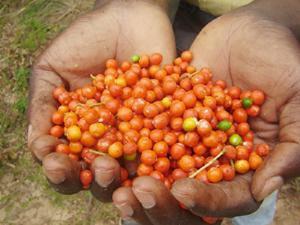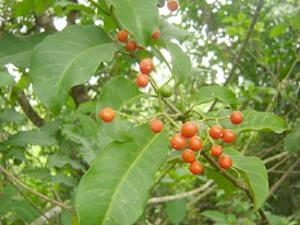Orou Gaoue
Other projects
8 Oct 2009
Population Dynamics of Voacanga africana and Implications for its Conservation in Benin
This project objectives are to:
(1) understand and map the geographic distribution and morphological variation, and uses of R. vomitoria;
(2) study the dynamic of representative populations in order to provide arguments to confirm the conservation status of the species,
(3) to investigate seed longevity for a domestication plan and encourage its plantation.

Rauvolfia vomitoria mature fruits harvested by the research team
Indigenous people have been using medicinal plants for centuries. In Africa, 80% of the populations rely on traditional medicine for primary health care. In addition to non-commercial harvest of many plants for medicinal purposes, commercial harvest has increased the threat to extinction of many species. Unfortunately, we still lack information on the biology, distribution of even the common medicinal plants in many countries. In addition, we simply ignore the impact of harvesting on the survival of the most endangered species while many of them are not domesticated.

Mature and immature fruits of Rauvolfia vomitoria
The Medical Plant Group – Benin is a team of young scientists from Benin who start thinking about how to provide first hand data on the most endangered medicinal plant in the country. Rauvolfia vomitoria, although it is not listed even in the Red List of Benin plants (which is unrealistic), is one of the most endangered medicinal plants in Benin. Its spatial distribution, as well as its ecology and conservation status is still unknown in the country. It is a medicinal plants threatened in its habitat and overexploited by local people to treat psychoses and other psychiatric disorders.
This project objectives are to:
(1) understand and map the geographic distribution and morphological variation, and uses of R. vomitoria;
(2) study the dynamic of representative populations in order to provide arguments to confirm the conservation status of the species;
(3) to investigate seed longevity for a domestication plan and encourage its plantation.
This project on R. vomitoria will set the tone for similar studies on many other endangered plant species (not only medicinal but also species used widely by people). This will provide the forestry department and other Non Governmental Organization strongly involved into conservation of nature, the key information missing to justify many of their field activities, and also provide technical information for better sustainable management plan of the species.